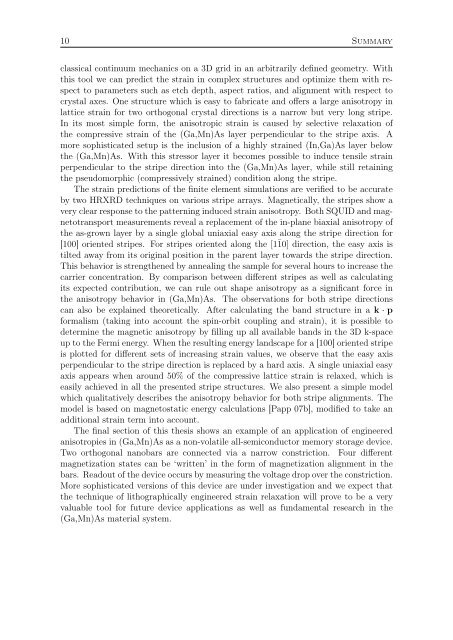Ferromagnetic (Ga,Mn)As Layers and ... - OPUS Würzburg
Ferromagnetic (Ga,Mn)As Layers and ... - OPUS Würzburg
Ferromagnetic (Ga,Mn)As Layers and ... - OPUS Würzburg
You also want an ePaper? Increase the reach of your titles
YUMPU automatically turns print PDFs into web optimized ePapers that Google loves.
10 Summary<br />
classical continuum mechanics on a 3D grid in an arbitrarily defined geometry. With<br />
this tool we can predict the strain in complex structures <strong>and</strong> optimize them with respect<br />
to parameters such as etch depth, aspect ratios, <strong>and</strong> alignment with respect to<br />
crystal axes. One structure which is easy to fabricate <strong>and</strong> offers a large anisotropy in<br />
lattice strain for two orthogonal crystal directions is a narrow but very long stripe.<br />
In its most simple form, the anisotropic strain is caused by selective relaxation of<br />
the compressive strain of the (<strong>Ga</strong>,<strong>Mn</strong>)<strong>As</strong> layer perpendicular to the stripe axis. A<br />
more sophisticated setup is the inclusion of a highly strained (In,<strong>Ga</strong>)<strong>As</strong> layer below<br />
the (<strong>Ga</strong>,<strong>Mn</strong>)<strong>As</strong>. With this stressor layer it becomes possible to induce tensile strain<br />
perpendicular to the stripe direction into the (<strong>Ga</strong>,<strong>Mn</strong>)<strong>As</strong> layer, while still retaining<br />
the pseudomorphic (compressively strained) condition along the stripe.<br />
The strain predictions of the finite element simulations are verified to be accurate<br />
by two HRXRD techniques on various stripe arrays. Magnetically, the stripes show a<br />
very clear response to the patterning induced strain anisotropy. Both SQUID <strong>and</strong> magnetotransport<br />
measurements reveal a replacement of the in-plane biaxial anisotropy of<br />
the as-grown layer by a single global uniaxial easy axis along the stripe direction for<br />
[100] oriented stripes. For stripes oriented along the [1¯10] direction, the easy axis is<br />
tilted away from its original position in the parent layer towards the stripe direction.<br />
This behavior is strengthened by annealing the sample for several hours to increase the<br />
carrier concentration. By comparison between different stripes as well as calculating<br />
its expected contribution, we can rule out shape anisotropy as a significant force in<br />
the anisotropy behavior in (<strong>Ga</strong>,<strong>Mn</strong>)<strong>As</strong>. The observations for both stripe directions<br />
can also be explained theoretically. After calculating the b<strong>and</strong> structure in a k · p<br />
formalism (taking into account the spin-orbit coupling <strong>and</strong> strain), it is possible to<br />
determine the magnetic anisotropy by filling up all available b<strong>and</strong>s in the 3D k-space<br />
up to the Fermi energy. When the resulting energy l<strong>and</strong>scape for a [100] oriented stripe<br />
is plotted for different sets of increasing strain values, we observe that the easy axis<br />
perpendicular to the stripe direction is replaced by a hard axis. A single uniaxial easy<br />
axis appears when around 50% of the compressive lattice strain is relaxed, which is<br />
easily achieved in all the presented stripe structures. We also present a simple model<br />
which qualitatively describes the anisotropy behavior for both stripe alignments. The<br />
model is based on magnetostatic energy calculations [Papp 07b], modified to take an<br />
additional strain term into account.<br />
The final section of this thesis shows an example of an application of engineered<br />
anisotropies in (<strong>Ga</strong>,<strong>Mn</strong>)<strong>As</strong> as a non-volatile all-semiconductor memory storage device.<br />
Two orthogonal nanobars are connected via a narrow constriction. Four different<br />
magnetization states can be ‘written’ in the form of magnetization alignment in the<br />
bars. Readout of the device occurs by measuring the voltage drop over the constriction.<br />
More sophisticated versions of this device are under investigation <strong>and</strong> we expect that<br />
the technique of lithographically engineered strain relaxation will prove to be a very<br />
valuable tool for future device applications as well as fundamental research in the<br />
(<strong>Ga</strong>,<strong>Mn</strong>)<strong>As</strong> material system.
















